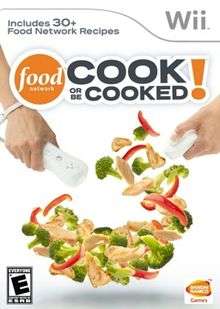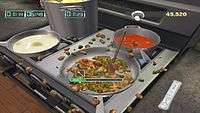Food Network: Cook or Be Cooked
| Food Network: Cook or Be Cooked | |
|---|---|
 Cover art | |
| Developer(s) | Red Fly Studio |
| Publisher(s) | Namco Bandai Games |
| Engine | Infernal |
| Platform(s) | Wii |
| Release date(s) |
|
| Genre(s) | Simulation, minigame |
| Mode(s) | Single player, multiplayer |
Food Network: Cook or Be Cooked is a cooking simulation-styled minigame compilation developed by Red Fly Studio and published by Namco Bandai Games. It was released exclusively in North America on November 3, 2009, and is the first video game to use the Food Network license.[1][2] As this game derives its recipes from the Food Network cookbook How to Boil Water, it is also one of only dozens of video games in history to be based on a book.
Cook or Be Cooked contains twelve different meals to prepare; the player must go through recipes and complete the meals by completing minigames correctly. The game features a single player mode, a "pass and play" mode allowing up to four players to prepare one meal, and a multiplayer cook-off mode between two people. Cook or Be Cooked garnered mediocre reviews from critics upon release, who noted a lack of content in the game. As of August 2010, Cook or Be Cooked has received compilation scores of 53% and 64% from Metacritic and GameRankings respectively.[3][4]
This game is also the only known Wii cooking video game to utilize two-handed controls, as opposed to simply using just the Wii Remote.
Gameplay

The game places the player in a kitchen and tasks them with cooking meals to be judged upon completion.[5]
Controls are done utilizing the motion controls of the Wii Remote and Nunchuk to cook and prepare food.[5] Meals consist of multiple dishes which must be served at the same time so that they remain hot enough to be enjoyable; the game requires the player to manage their time while cooking. Recipes range from "Bill Wallace's Famous Clam Dip" to a classic spaghetti and meatballs.[6] The game gives feedback to the player while they're cooking through pop-up messages and in-game commentary, which note problems in players' cooking styles or timing. Players are scored based on their performance during cooking.[5]
History
The game was first publicized by a press release on April 29, 2009, in which the game's title and the partnership between Namco Bandai and the Food Network was announced.[7][8] The game was released on November 3, 2009.[5]
Reception
Cook or Be Cooked garnered mediocre reviews from critics mainly for its lack of content; it received compilation scores of 53% and 64% from Metacritic and GameRankings respectively.[3][4] GameSpot's Shaun Mcinnis noted that though the gameplay itself controlled tightly and was fun, it held little replay value because of the lack of dishes to create. David Wolinsky of the The A.V. Club described the game as immersive when it worked, but felt the game's small selection of recipes made the fun short-lived.[1] 1UP.com's Mike Cruz stated that the game could be finished in one sitting.[9]
References
- 1 2 Wolinsky, David (November 30, 2009). "Food Network: Cook or Be Cooked!". The A.V. Club. Retrieved December 12, 2009.
- ↑ "Cook like a pro in the first video game from Food Network!". Nintendo. Retrieved 2009-12-13.
- 1 2 "Food Network: Cook or Be Cooked (wii) reviews". MetaCritic. Retrieved August 25, 2010.
- 1 2 "Food Network: Cook or Be Cooked for Wii". GameRankings. Retrieved August 25, 2010.
- 1 2 3 4 Mcinnis, Shaun (November 19, 2009). "Food Network: Cook or Be Cooked Review for Wii". GameSpot. Retrieved December 12, 2009.
- ↑ "Food Network: Cook or Be Cooked". GameStop. Retrieved 2016-01-25.
- ↑ "Namco Bandai and Food Network Announce Food Network: Cook or Be Cooked for Wii". Namco Bandai Games. April 29, 2009. Retrieved December 12, 2009.
- ↑ Thorsen, Tor (November 10, 2009). "Namco's Wii wave exercises, cooks, and cheers". GameSpot. Retrieved December 12, 2009.
- ↑ Cruz, Mike (November 10, 2009). "Food Network Cook or Be Cooked Review for the Wii". 1UP.com. Retrieved December 12, 2009.